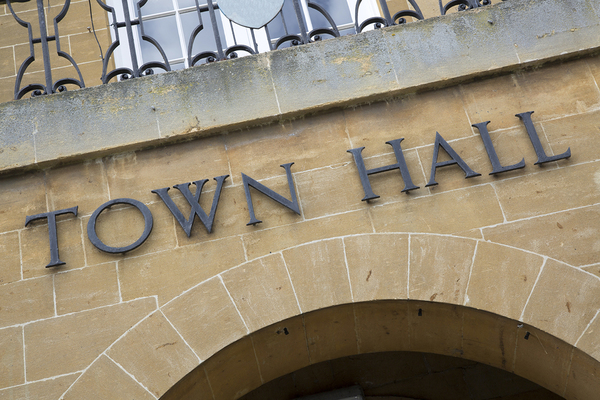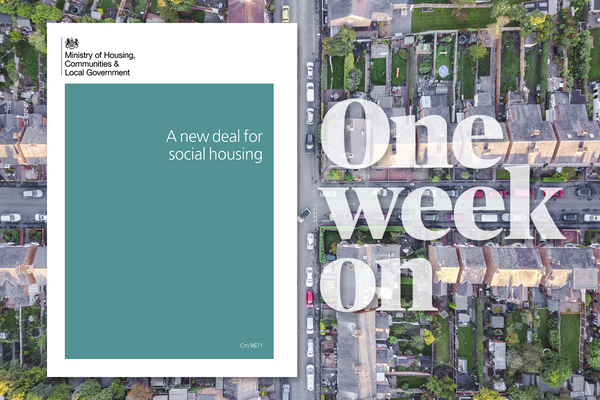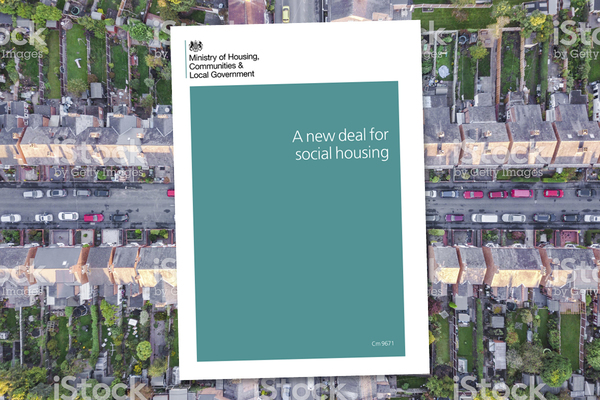You are viewing 1 of your 1 free articles
Did the green paper address concerns raised by tenants on Alok Sharma’s roadshow?
Did the government listen to tenants’ concerns? Peter Apps marks sections of the Social Housing Green Paper out of 10
Last week’s Social Housing Green Paper was developed in a starkly different way to previous Conservative housing policy documents.
Rather than rely on thinktanks, industry consultation or the whims of George Osborne, this time the housing minister was sent out to talk to social housing tenants about what they wanted.
In the aftermath of Grenfell, some of this was clearly about optics. The government wanted to look like it was listening to people who felt ignored. But did it really listen?
Analysing this was always going to be difficult. The government refused all requests to allow media representatives to attend the roadshows and published no summary of the issues raised.
Therefore Inside Housing worked backwards, contacting tenants who attended and asking them what was raised.
Eventually we received a copy of a letter from former housing minister Alok Sharma, outlining the concerns raised at one session.
This provides the only – if a slightly incomplete – framework to assess how well the final green paper delivered against tenants’ concerns. In the letter, he listed seven areas. And so it is these we will use to score the green paper.
1. Stigma
Mr Sharma’s letter notes that he was told “tenants felt strongly about the need to address negative perceptions associated with social housing”. This is something the final paper dedicates an entire chapter to addressing, but sadly the ideas don’t quite match the column inches.
Proposals to launch a ‘best neighbourhood competition’ and win a street party can at best be described as fluffy and at worst tin-eared and patronising.
The rest of the chapter does little more than pose questions about how social landlords could become better at neighbourhood management, without much by way of potential answers.
“The truth is that the stigma of social housing tenants has not happened in a vacuum separate from government policy.”
In some ways this was always going to be a difficult problem for a policy paper to grapple with. You can’t legislate away bigots or undo entrenched negative stereotypes with a consultation.
The truth is that the stigma of social housing tenants has not happened in a vacuum separate from government policy.
The welfare cuts of recent years have exacerbated poverty and deliberately pandered to the worst stereotypes held by Middle England about benefit claimants. Homeownership has always been labelled the pinnacle of aspiration by minister after minister – with the obvious implication that the inverse is true.
As recently as January 2016, an official government press release pledged to demolish and rebuild the country’s “sink estates”.
David Cameron gave his name to an accompanying quote with a view of social housing gleaned straight from corny urban drama. “Step outside in the worst estates and you’re confronted by brutal high-rise towers and dark alleyways that are a gift to criminals,” he said.
“Decades of neglect have led to gangs and anti-social behaviour. And poverty has become entrenched, because those who could afford to move have understandably done so.”
Perhaps then, the most meaningful thing the government could have done on stigma would be to acknowledge, apologise for and promise to address the role its own policies and rhetoric have played in creating it.
Street party awards will achieve little.
1/10
2. Affordable and supported housing stock
“Tenants felt that affordable rents are not really affordable,” Mr Sharma noted in his letter. While an obvious point to anyone following housing policy, a Conservative minister putting this in black and white was something of a revelation. It was not, however, a concern that was reflected in the green paper.
The chief criticism of the document in the mainstream press is that it has no muscular policies on supplying new homes and crucially no cash.
Should policymakers have wanted to move away from the affordable rent regime in the paper, then they would have needed to knock on the door of the Treasury for sign-off on higher grant rates and an end to the process of ‘converting’ lower social rents to affordable in order to make up for low levels of government funding.
Who knows whether this approach was made? If it was, it wasn’t successful, because there is nothing at all in the document about the difference between social and affordable rents.
Since the launch of the roadshows the government has committed to funding some social rent again, both directly and through Sadiq Khan’s London programmes. It also gives welcome confirmation that existing social housing will not be sold off under the high-value asset levy.
This is certainly progress, but there is also the sense of opportunity lost.
3/10
3. Investment and safety
“The view was expressed that a lack of central government investment has led to cuts in services and safety standards falling,” wrote Mr Sharma, in another unusually candid acknowledgement of his own regime’s shortcomings.
There is some cheer here in the green paper. While it was somewhat buried, the suggestion that the Decent Homes Standard could be revised for the first time since 2006 is a major shift.
This would be an opportunity for the government to prescribe higher standards across the social housing sector, and may well result in funding commitments to achieve them – which have gone hand in hand with Decent Homes programmes in the past.
“On the safety side though, more immediate action is needed.”
What is possibly more significant is the tonal shift. Conservative policy documents on housing have been really all about supply, and specifically the supply of homeownership.
To turn their minds to existing social housing stock and investing in making it better – a priority typically associated with Labour administrations – is evidence that at least some areas of government are taking seriously the need for change.
These are not concrete ideas yet, there is no funding yet. But talking about Decent Homes again is a welcome step.
That’s the investment side. On the safety side though, more immediate action is needed. There is spiralling evidence of a systemic issue with fire doors.
Many buildings – private and social – are still clad with flammable materials. Windows and insulation systems pose undiscovered fire risks.
Post-Grenfell, this requires swift action, not consultation, and the government has been too slow too often.
5/10
4. Community
“Attendees noted the need to address isolation and better understand how a lack of opportunities for local residents can contribute to the fragmentation of communities,” wrote Mr Sharma.
It is tempting to file this in the same bracket as tackling stigma, in the sense that it is an objective which is simply bigger than a policy paper.
Isolation and fragmented communities probably have their heart in the way our economy has left certain communities behind over the past 30 years and that isn’t something the Ministry of Housing, Communities and Local Government can reverse.
The introduction of lots of short-term private rented housing to many estates through the vehicle of the Right to Buy has not helped, but this paper was never going to reverse the Right to Buy.
In the substance of what it has suggested, responsible neighbourhood management and tackling anti-social behavior will be included as metrics for the new league tables. Although how you sensibly measure and compare this is a problem left to be solved later.
Elsewhere the paper simply posed the question: “How are landlords working with local partners to tackle anti-social behaviour?” A policy the government wants to address, but not one it has many ideas on – yet.
2/10
5. Communication and tenant voice
The paper is also extremely light on detail about how to improve the crucial issue of resident engagement.
“Are current resident engagement and scrutiny measures effective? What more can be done to make residents aware of existing ways to engage with landlords and influence how services are delivered?” it asks.
It may be unfair to criticise a green paper for not being specific enough, but this is an area where the paper is so green as to be positively verdant.
“It is disappointing not to see something more concrete.”
It has no clear policy proposal at all, and really just repeats a question which it was set up to ask. Considering a year has been spent on the development of this document, it is disappointing not to see something more concrete.
It also floats the idea of “stronger representation for tenants at a national level”. The National Tenant Voice was set up to do precisely this job by Gordon Brown in February 2010 and was scrapped as soon as the Conservatives came to power in July of that year.
You can spin this in one of two ways. One: it is interesting to see the government pendulum swinging back in a direction it has previously ignored, and indicative that this marks a genuine break from the approach of the past eight years. Or two: it is frustrating to be back at the early development stage of an idea that has already been implemented and abandoned once this decade.
Whichever side you come down on, it merits no more than 4/10.
6. Quality of service
Mr Sharma’s letter notes “standards are still low” in terms of service delivery and that “there are no clear ways for management to be held to account”. This is an area the green paper very much wants to deal with: it is something the survivors of the Grenfell Tower fire are adamant must be addressed.
The plan is, essentially, to give the regulator power to intervene on tenant services. As with the above paragraphs on the National Tenant Voice, this would mean the reversal of decisions made in 2010. That era saw the regulator reformed to focus almost exclusively on economic issues. Consumer affairs – repairs, neighbourhood management, services etc – fell under a ‘serious detriment’ test, and the regulator was told fairly clearly not to bother too much with them.
“Will the regulator be expected to investigate and intervene on specific complaints by tenants, or will the Housing Ombudsman Service by given a boosted role in that respect?”
The pendulum will clearly move now though, post-Grenfell, and the regulator will be given some power to intervene more directly in issues which affect tenants.
Will this be through the simple process of including service delivery in in-depth assessments? Will a specific consumer standard be introduced? Will the regulator be expected to investigate and intervene on specific complaints by tenants, or will the Housing Ombudsman be given a boosted role in that respect?
The government clearly wants to get the balance right here. It has legitimate pressure from survivors of the fire and tenant groups to act. It will also weigh the views of lenders and financiers who value the security provided by economic regulation. Neither will it want to make housing associations so focused on service delivery that they forget about new supply. It is a delicate balance, but one where a sense of direction and travel has at least been struck.
6/10
7. Welfare and benefits
The elephant in the spare bedroom. All of those who went to the tenant roadshows said issues around welfare, particularly Universal Credit, were central to the discussion.
The fact that this got a cursory one sentence in Mr Sharma’s letter suggests he knew there would be no action resulting from the Social Housing Green Paper, and so it has proved.
The green paper actually finds time to praise Universal Credit, saying it “supports the rebalancing of power between residents and landlords in the social sector”.
Well it may do, but only in the instances where it is paid in full and on time. Sending someone to a food bank while they wait for their first benefit cheque does nothing for stigma. Putting them in arrears does nothing for their relationship with their landlord. A broken welfare system does not help integrate communities.
This is an issue the Social Housing Green Paper never had the remit to cover. But many tenants will wish it did.
0/10
Average score: 3/10
Peter Apps, news editor, Inside Housing
Listen to a discussion about the Social Housing Green Paper on The Housing Podcast:
Social Housing Green Paper: full coverage
All our Social Housing Green Paper coverage in one place:
Green paper measures are not enough to create May’s ‘new generation’ of council homes Green paper proposals are welcome but much more is needed to support councils to build, writes John Bibby
Green paper shows ministers now see associations as trusted partners Focusing on the failure of the green paper to address supply misses the point, writes Boris Worrall
Government should focus on building on what is already strong Philippa Jones considers the Social Housing Green Paper through a slightly different lens
We need more than a week of delayed announcements bundled together Jules Birch reflects on the government’s ‘Housing Week’ announcements
The regulator should monitor how associations assist homeless people Government announcements this week are positive, but any enhanced role for the English regulator should include looking at homelessness prevention work, argues David Bogle
The regulator’s role should be limited to dealing with systemic failures Julian Ashby suggests the Housing Ombudsman Service should deal with all complaints
The green paper shows ministers are in listening mode Despite some glaring omissions, the government appears to be in listening mode and it is important the sector takes advantage, argues Emma Maier
A short history of social housing league tables Attempts to create league tables for housing associations are nothing new. Mervyn Jones looks at how they have worked in the past
League tables could prove blunt and counter-productive, sector warns Housing figures criticise government proposals to measure social landlords against performance indicators
Government ‘must decide how proactive regulator should be’ on consumer standards Ministers now face a dilemma over the regulator’s focus, sector figures say
The Green Paper: a golden opportunity missed? Melanie Rees assesses the Social Housing Green Paper against recommendations drawn up by the Chartered Institute of Housing and finds the government comes up short
Longer strategic partnerships and guranteed debt to boost social housebuilding The Social Housing Green Paper outlines key ways of boosting supply
The green paper is remarkable progress but it is still not enough The green paper suggests the government appears to be re-writing much of its policy since 2010, but more needs to be done, writes Jules Birch
Green paper marks a ‘milestone’ on resident involvement The government’s recognition residents need clear information is to be welcomed, now it up to the sector to embrace tenant involvement, writes Paul Hackett
Ministers consider stock transfer programme to community-led associations The stock transfer programme could be revived under proposals in the housing green paper
Access to housing grant could be tied to new league tables Grant could be awarded according to how well landlords meet performance indicators, the paper suggests
Ofsted-style regulation of tenant services proposed The government is considering expanding the Regulator for Social Housing’s remit to intervene over tenant services and give it a more “proactive approach to enforcement”
Government proposes dropping one-for-one Right to Buy replacement commitment A consultation paper published alongside the green paper proposes a broader measurement to replace the one-for-one pledge
A list of recent housing policy U-turns The green paper confirms yet more housing policy U-turns from the government, which has spent the past two years dropping policy ideas developed under the David Cameron government. Here is a rundown of the major changes in policy direction
Sector welcomes green paper but calls for more ‘ambitious investment’ Reaction to the proposals, from the National Housing Federation, Chartered Institute of Housing and more
Morning Briefing: reaction to green paper announcements how the media reported the proposals trailed by the government overnight
Government drops plans to force councils to sell higher-value stock The government drops plans to force councils to sell higher value homes
League tables and ‘sharper teeth’ for regulator in social housing green paper Ministers reveal some of the things in the paper ahead of its publication
Grenfell survivors: green paper does not go far enough survivors of the Grenfell Tower fire have said the measures published in the Social Housing Green Paper do not do enough to rectify issues in the social housing sector
KEY PROPOSALS IN THE SOCIAL HOUSING GREEN PAPER
- New 'league tables' of housing providers based on key performance indicators, surrounding services such as repairs and neighbourhood management. This could be linked to housing grant.
- Consideration to scrapping of the current 'serious detriment' test, to allow 'Ofsted-style' tougher consumer regulation
- New home ownership options such as allowing tenants to buy as little as 1% of their property each year through shared ownership. This would only apply to new shared ownership purchases.
- Ditching of plans to force social landlords to offer fixed term tenancies rather than lifetime tenancies in social housing
- Ditching of plans to force councils to sell off their most valuable social housing when it becomes vacant
- The potential introduction a new stock transfer programme from councils to 'community-led' housing associations
- The return of guaranteed debt funding to help the development of affordable homes, and longer term 'strategic partnerships' for developing housing associations















